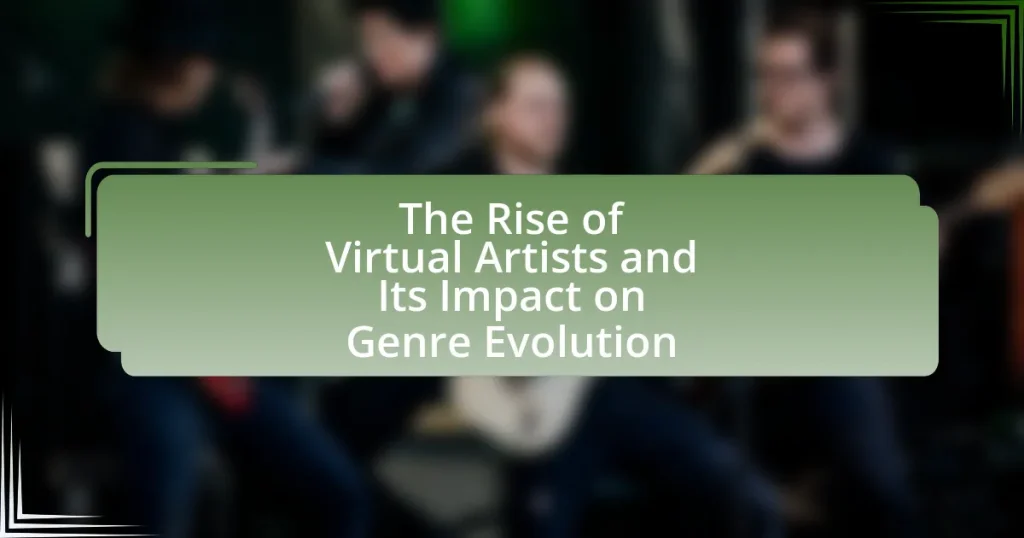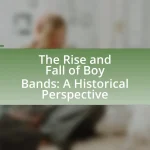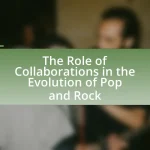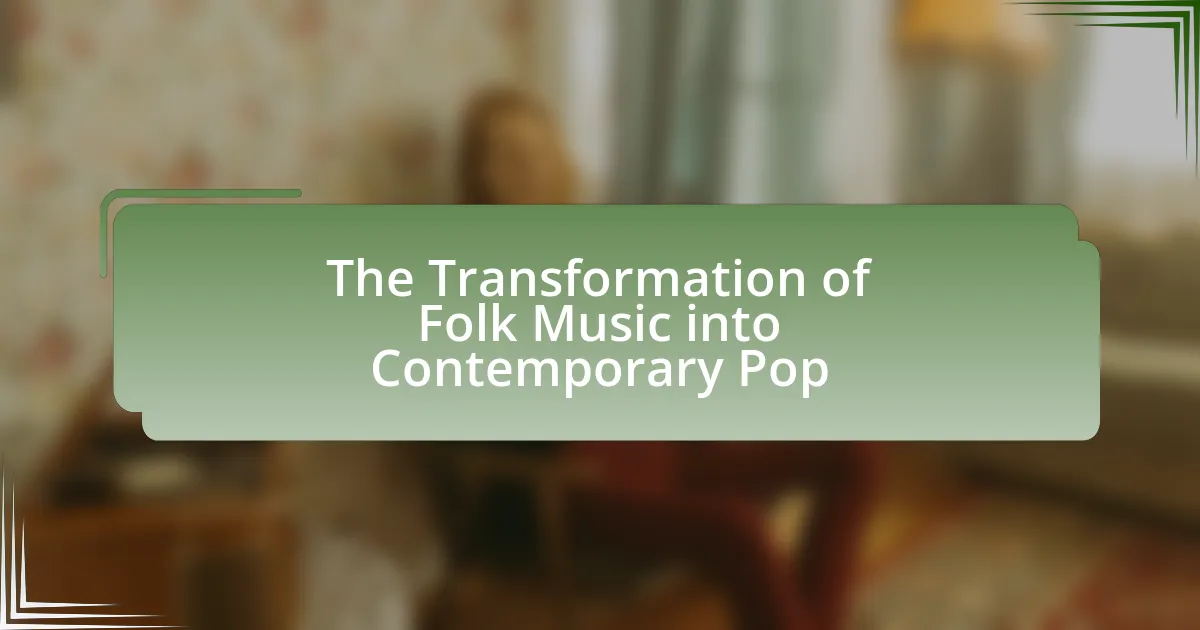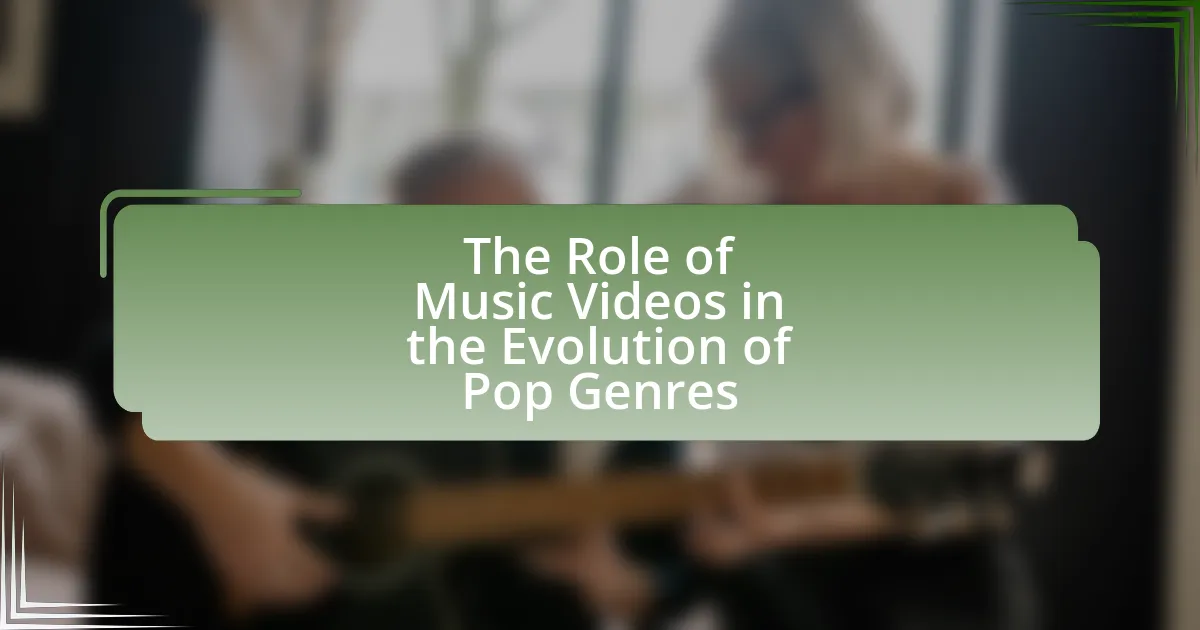Virtual artists are digital entities created through artificial intelligence and computer-generated imagery, capable of producing music, visual art, and performances. Their emergence is driven by advancements in technology, particularly AI algorithms and graphics rendering, which allow for lifelike avatars and innovative compositions. This article explores the differences between virtual and traditional artists, the technologies enabling their creation, and their significant impact on music genres and cultural shifts. It also addresses the challenges and opportunities presented by virtual artists, including copyright issues and the evolving role of human artists in the industry. The future trends of virtual artists suggest a continued blending of genres and enhanced audience engagement through immersive experiences.
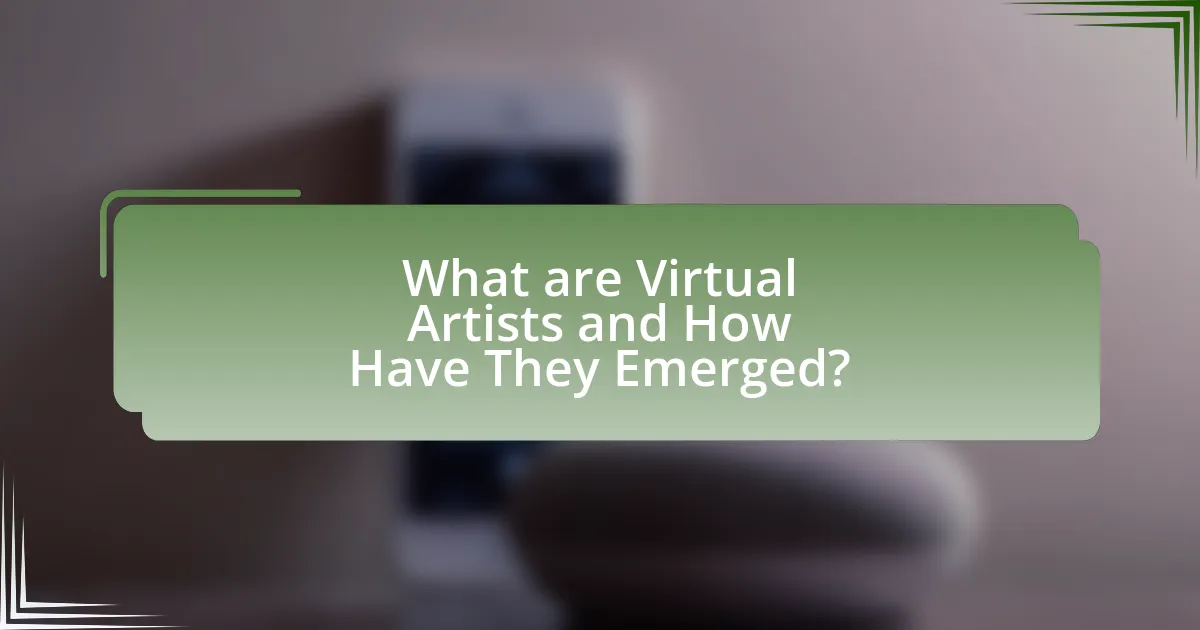
What are Virtual Artists and How Have They Emerged?
Virtual artists are digital entities created using artificial intelligence and computer-generated imagery, capable of producing music, visual art, and performances. They have emerged due to advancements in technology, particularly in AI algorithms and graphics rendering, which allow for the creation of lifelike avatars and compositions. The rise of platforms like Hatsune Miku, a virtual pop star developed in Japan, exemplifies this trend, as she gained popularity through live performances and music releases, attracting millions of fans globally. Additionally, the integration of virtual artists into social media and streaming services has facilitated their widespread acceptance and influence in the entertainment industry.
How do Virtual Artists differ from Traditional Artists?
Virtual artists differ from traditional artists primarily in their medium and methods of creation. Virtual artists utilize digital tools and platforms to create art, often leveraging software like Adobe Photoshop or 3D modeling programs, while traditional artists typically work with physical materials such as paint, canvas, or clay. This distinction allows virtual artists to experiment with techniques that are not possible in traditional mediums, such as animation and interactive installations. Additionally, virtual artists can easily share their work online, reaching a global audience instantly, whereas traditional artists may rely on galleries and physical exhibitions for exposure. This shift in medium and distribution has significantly influenced the evolution of artistic genres, leading to the emergence of new forms like digital art and virtual reality experiences.
What technologies enable the creation of Virtual Artists?
Technologies that enable the creation of Virtual Artists include artificial intelligence, machine learning algorithms, and computer-generated imagery (CGI). Artificial intelligence facilitates the generation of music, art, and performances by analyzing existing works and creating new content based on learned patterns. Machine learning algorithms enhance this process by improving the accuracy and creativity of the outputs through iterative training on vast datasets. CGI is crucial for visual representation, allowing for the creation of lifelike avatars and environments that Virtual Artists inhabit. These technologies collectively contribute to the emergence and evolution of Virtual Artists in the entertainment industry.
What are the key characteristics of Virtual Artists?
Virtual artists are characterized by their digital creation and performance capabilities, often utilizing advanced technologies such as artificial intelligence and animation. These artists can produce music, visual art, and performances without physical presence, allowing for innovative expressions that blend various genres. Their work often involves collaboration with software and algorithms, enabling unique styles and outputs that reflect contemporary digital culture. Additionally, virtual artists engage with audiences through social media and virtual platforms, enhancing their reach and interaction. This evolution in artistry is supported by the increasing acceptance of digital mediums in mainstream culture, as evidenced by the success of virtual performers like Hatsune Miku and the rise of AI-generated music.
Why is the Rise of Virtual Artists Significant?
The rise of virtual artists is significant because it represents a transformative shift in the music industry, enabling new forms of creativity and audience engagement. Virtual artists, such as Hatsune Miku and Lil Miquela, leverage technology to create music and performances that blend digital and physical realms, attracting millions of fans globally. This phenomenon has led to the emergence of new genres and styles, as virtual artists often collaborate with human musicians and producers, pushing the boundaries of traditional music creation. Furthermore, the integration of virtual artists into mainstream culture highlights the growing acceptance of digital personas, which can generate substantial revenue through merchandise, virtual concerts, and streaming platforms. This shift not only reflects changing consumer preferences but also indicates a broader evolution in how art and entertainment are produced and consumed in the digital age.
How do Virtual Artists challenge conventional art forms?
Virtual artists challenge conventional art forms by utilizing digital technology to create immersive and interactive experiences that traditional mediums cannot offer. This innovation allows for the exploration of new aesthetics and concepts, such as generative art, which evolves through algorithms, and virtual reality installations that engage audiences in ways that physical art cannot. For instance, the rise of platforms like Art Blocks has enabled artists to produce unique, algorithmically generated pieces, pushing the boundaries of authorship and originality in art. Additionally, virtual artists often leverage social media and online communities to democratize art access, contrasting with the exclusivity of traditional galleries. This shift not only redefines the artist-audience relationship but also expands the definition of art itself, as seen in the growing acceptance of NFTs, which challenge ownership and value in the art market.
What cultural shifts accompany the rise of Virtual Artists?
The rise of Virtual Artists is accompanied by significant cultural shifts, including the redefinition of creativity, the democratization of art production, and the transformation of audience engagement. Virtual Artists challenge traditional notions of authorship and originality, as they are often created and controlled by algorithms or teams rather than individual human creators. This shift has led to a broader acceptance of digital and AI-generated content in mainstream culture, as seen in the increasing popularity of virtual influencers and musicians like Hatsune Miku, who has garnered millions of fans worldwide. Additionally, the accessibility of technology allows more individuals to create and share art, fostering a more inclusive artistic community. This cultural evolution is evidenced by the rise of platforms like TikTok and Instagram, where users can easily produce and distribute their creative works, further blurring the lines between artist and audience.
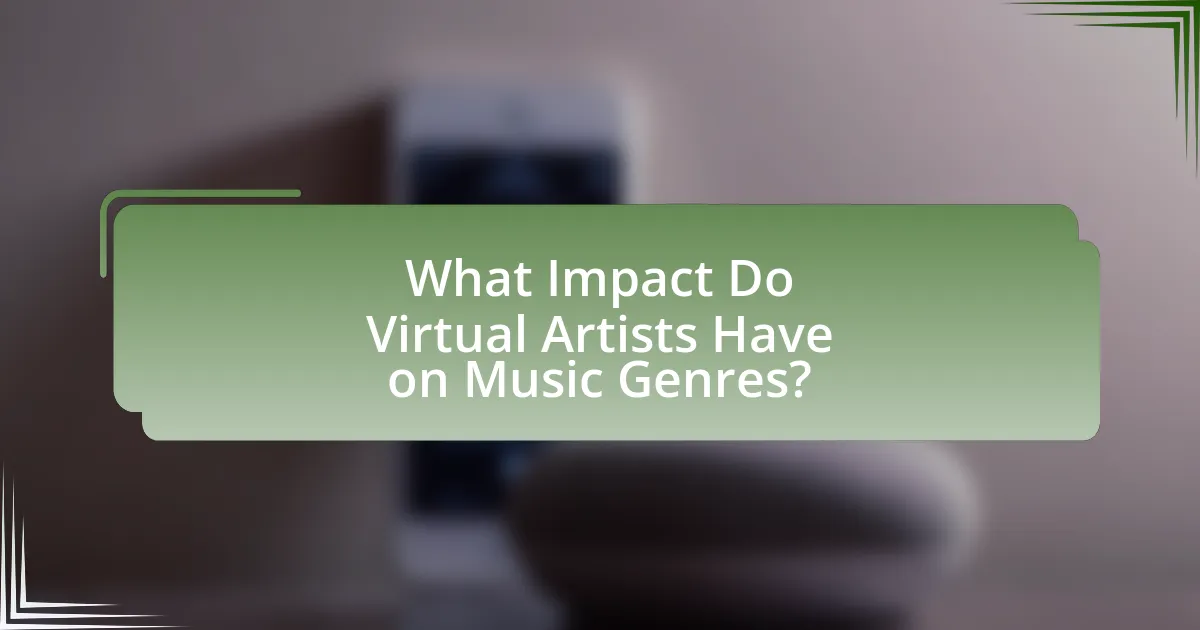
What Impact Do Virtual Artists Have on Music Genres?
Virtual artists significantly influence music genres by introducing innovative sounds and aesthetics that challenge traditional boundaries. They often blend various styles, leading to the emergence of new subgenres and hybrid forms. For instance, the virtual artist Hatsune Miku has popularized Vocaloid music, which combines electronic pop with synthesized vocals, creating a distinct genre that attracts diverse audiences. Additionally, virtual artists like Gorillaz have successfully merged alternative rock with hip-hop and electronic music, demonstrating how digital personas can reshape genre definitions and listener expectations. This impact is evidenced by the growing presence of virtual artists in mainstream charts and their ability to engage global audiences through digital platforms, thus altering the landscape of music consumption and production.
How are Genres Evolving Due to Virtual Artists?
Genres are evolving due to virtual artists by blending traditional musical styles with digital innovation, leading to the emergence of new subgenres. Virtual artists, such as Hatsune Miku and Lil Miquela, utilize technology to create music that often incorporates elements from various genres, including pop, electronic, and hip-hop, resulting in hybrid sounds that appeal to diverse audiences. For instance, the rise of virtual pop stars has led to the creation of music that combines J-pop with Western pop influences, showcasing a globalized approach to genre development. This evolution is supported by the increasing popularity of virtual concerts and collaborations, which further blur the lines between genres and challenge conventional music industry norms.
What new genres have emerged from the influence of Virtual Artists?
New genres that have emerged from the influence of Virtual Artists include digital pop, virtual rap, and AI-generated electronic music. Digital pop blends traditional pop elements with synthesized sounds and virtual performances, exemplified by artists like Hatsune Miku. Virtual rap has gained traction with AI-generated lyrics and beats, as seen in projects like OpenAI’s Jukebox. AI-generated electronic music showcases algorithmically produced tracks that push the boundaries of sound design, reflecting the capabilities of machine learning in music creation. These genres illustrate the transformative impact of Virtual Artists on the music landscape.
How do Virtual Artists blend different musical styles?
Virtual artists blend different musical styles by utilizing advanced algorithms and machine learning techniques to analyze and combine elements from various genres. These artists often draw from a vast database of musical samples, allowing them to seamlessly integrate rhythms, melodies, and harmonies from diverse influences, such as electronic, hip-hop, and classical music. For instance, the virtual artist YACHT released an album created entirely by artificial intelligence, showcasing how technology can merge distinct musical characteristics to produce innovative sounds. This blending not only reflects the versatility of virtual artists but also contributes to the evolution of music genres, as seen in the rise of hybrid genres like lo-fi hip-hop and trap-infused pop.
What Role Do Virtual Artists Play in Genre Popularity?
Virtual artists significantly influence genre popularity by creating unique content that attracts diverse audiences. Their ability to blend various musical styles and visual aesthetics allows them to innovate within genres, often leading to the emergence of new subgenres. For instance, virtual artists like Hatsune Miku have popularized J-pop globally, demonstrating how digital personas can transcend cultural boundaries and engage fans across different regions. Additionally, the rise of platforms like TikTok has enabled virtual artists to reach wider audiences quickly, further enhancing their impact on genre trends. This phenomenon is supported by data showing that tracks featuring virtual artists often achieve higher streaming numbers, indicating their role in shaping listener preferences and genre dynamics.
How do Virtual Artists influence listener preferences?
Virtual artists influence listener preferences by creating unique, genre-blending music that resonates with diverse audiences. Their ability to produce innovative sounds and visuals attracts listeners who seek fresh experiences, often leading to shifts in musical tastes. For instance, the rise of virtual artists like Hatsune Miku has demonstrated how digital personas can engage fans through interactive performances and social media, fostering a community that shapes listener preferences. Additionally, studies show that virtual artists can drive trends in music consumption, as their collaborations with established musicians often lead to increased exposure and acceptance of new genres among listeners.
What impact do Virtual Artists have on mainstream music trends?
Virtual artists significantly influence mainstream music trends by introducing innovative sounds and aesthetics that reshape listener expectations. Their integration of technology and multimedia elements attracts diverse audiences, often leading to genre-blending and the emergence of new musical styles. For instance, the virtual artist Hatsune Miku has popularized vocaloid music, which combines synthesized vocals with various genres, impacting mainstream pop and electronic music. Additionally, the rise of virtual performances during the COVID-19 pandemic demonstrated their ability to engage audiences in new ways, further solidifying their role in shaping contemporary music trends.
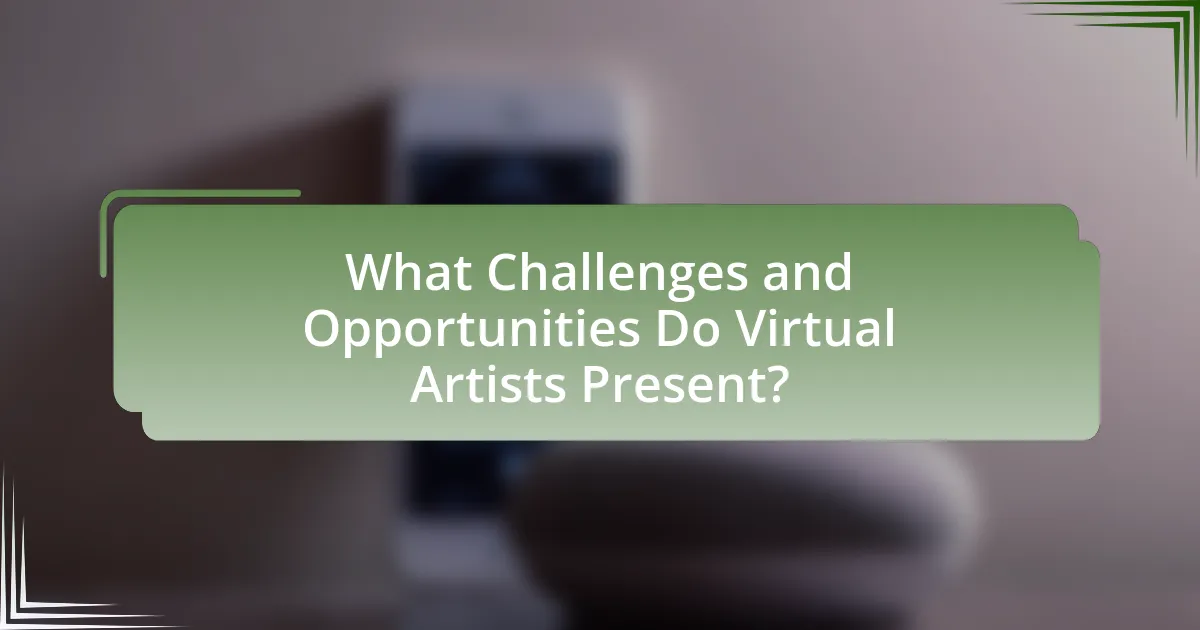
What Challenges and Opportunities Do Virtual Artists Present?
Virtual artists present both significant challenges and unique opportunities within the creative landscape. The challenges include issues related to copyright, as the use of AI-generated content raises questions about ownership and intellectual property rights. Additionally, virtual artists may face skepticism from traditional artists and audiences who question the authenticity and emotional depth of digital creations. On the other hand, opportunities arise from the ability of virtual artists to reach global audiences through digital platforms, enabling innovative collaborations and the exploration of new artistic styles. The rise of virtual artists also fosters inclusivity, allowing diverse voices to emerge in the art world, as seen in the increasing popularity of virtual exhibitions and NFT marketplaces that democratize access to art.
What are the Ethical Considerations Surrounding Virtual Artists?
The ethical considerations surrounding virtual artists include issues of copyright, authenticity, and the potential for exploitation. Copyright concerns arise because virtual artists often utilize existing works or styles, leading to questions about ownership and originality. Authenticity is challenged as audiences may struggle to differentiate between human and virtual creators, impacting the perceived value of art. Additionally, the potential for exploitation exists, as companies may prioritize profit over the rights and welfare of virtual artists, particularly in terms of data usage and representation. These considerations highlight the need for clear guidelines and ethical frameworks to navigate the complexities introduced by virtual artists in the creative landscape.
How do Virtual Artists affect copyright and ownership issues?
Virtual artists significantly complicate copyright and ownership issues by challenging traditional definitions of authorship and intellectual property rights. These digital creators, often powered by algorithms or artificial intelligence, produce works that may not have a clear human author, leading to ambiguity in copyright claims. For instance, the U.S. Copyright Office has stated that works created by non-human entities may not qualify for copyright protection, which raises questions about who owns the rights to such creations. This situation is further complicated by the fact that virtual artists can generate content at scale, potentially infringing on existing copyrights without clear accountability. As a result, the legal frameworks surrounding copyright are being tested, necessitating updates to address the unique challenges posed by virtual artists in the digital landscape.
What are the implications for human artists in the industry?
The implications for human artists in the industry include increased competition from virtual artists, which can lead to a devaluation of traditional artistic skills. As virtual artists become more prevalent, human artists may face challenges in securing opportunities and recognition, as audiences may gravitate towards the novelty and accessibility of digital creations. This shift is evidenced by the growing popularity of AI-generated art, which has seen platforms like Artbreeder and DALL-E gain significant traction, highlighting a trend where consumers are increasingly open to non-human-generated content. Consequently, human artists may need to adapt by emphasizing unique personal styles, storytelling, and emotional depth that virtual artists cannot replicate, thereby redefining their roles within the evolving landscape of the art industry.
How Can Artists and Producers Collaborate with Virtual Artists?
Artists and producers can collaborate with virtual artists by utilizing digital platforms and technologies that facilitate remote creation and interaction. These collaborations often involve the use of software for music production, animation, and virtual reality, allowing for seamless integration of virtual artists into projects. For instance, platforms like Unreal Engine and Unity enable artists to create immersive experiences that blend real and virtual performances. Additionally, virtual artists can be programmed to respond to live inputs, enhancing the collaborative process. This approach has been validated by successful projects such as the virtual concert of the holographic rapper Tupac Shakur at Coachella in 2012, which showcased the potential for virtual artists to engage audiences alongside live performers.
What best practices should be followed when working with Virtual Artists?
When working with Virtual Artists, it is essential to establish clear communication and collaboration protocols. This ensures that all parties involved understand the artistic vision, technical requirements, and project timelines. Additionally, utilizing data analytics to gauge audience engagement can inform creative decisions, as evidenced by the success of virtual concerts that adapt in real-time to viewer preferences. Furthermore, respecting copyright and intellectual property rights is crucial, as the legal landscape surrounding virtual artists is still evolving. By adhering to these best practices, stakeholders can maximize the potential of virtual artists while minimizing risks.
How can traditional artists leverage Virtual Artists for their benefit?
Traditional artists can leverage Virtual Artists by collaborating on projects that blend traditional and digital art forms, enhancing their visibility and expanding their audience reach. This collaboration allows traditional artists to tap into the growing market for digital art, which has seen significant growth; for instance, the global digital art market was valued at approximately $3.5 billion in 2021 and is projected to continue expanding. By engaging with Virtual Artists, traditional artists can also explore new creative techniques and mediums, thereby enriching their artistic repertoire and staying relevant in an evolving art landscape.
What Future Trends Can We Expect from Virtual Artists?
Future trends from virtual artists include increased collaboration with human creators, enhanced use of artificial intelligence for music composition, and the rise of immersive experiences through virtual reality. As technology advances, virtual artists will likely leverage AI to create more complex and personalized music, as evidenced by projects like OpenAI’s MuseNet, which can generate compositions in various styles. Additionally, collaborations between virtual artists and human musicians are expected to grow, as seen in the success of virtual pop stars like Hatsune Miku, who has collaborated with numerous artists worldwide. The integration of virtual reality will also provide audiences with immersive concerts and experiences, reflecting a shift in how music is consumed and experienced.
How might technology further evolve the role of Virtual Artists?
Technology will further evolve the role of Virtual Artists by enhancing their creative capabilities through advanced tools like artificial intelligence, augmented reality, and blockchain. These technologies enable Virtual Artists to create more immersive and interactive experiences, allowing them to engage audiences in novel ways. For instance, AI algorithms can analyze audience preferences and generate personalized content, while augmented reality can transform how art is experienced in physical spaces. Additionally, blockchain technology facilitates ownership and monetization of digital art, empowering Virtual Artists to establish a sustainable income model. This evolution is supported by the increasing integration of these technologies in the creative industry, as seen in platforms like OpenAI’s DALL-E and Adobe’s Creative Cloud, which provide artists with innovative resources to expand their artistic expression.
What predictions can be made about the future of music genres influenced by Virtual Artists?
The future of music genres influenced by Virtual Artists is likely to see a significant diversification and hybridization of styles. As technology advances, Virtual Artists will increasingly blend elements from various genres, creating unique sounds that appeal to broader audiences. For instance, the rise of AI-generated music has already led to the emergence of genres like “algorithmic pop,” which combines traditional pop structures with experimental electronic sounds. This trend is supported by the growing popularity of platforms like Spotify, where listeners are exposed to a wider array of musical influences, leading to genre fusion. Additionally, Virtual Artists can easily adapt to changing listener preferences, allowing them to quickly innovate and evolve, further shaping the landscape of music genres.
